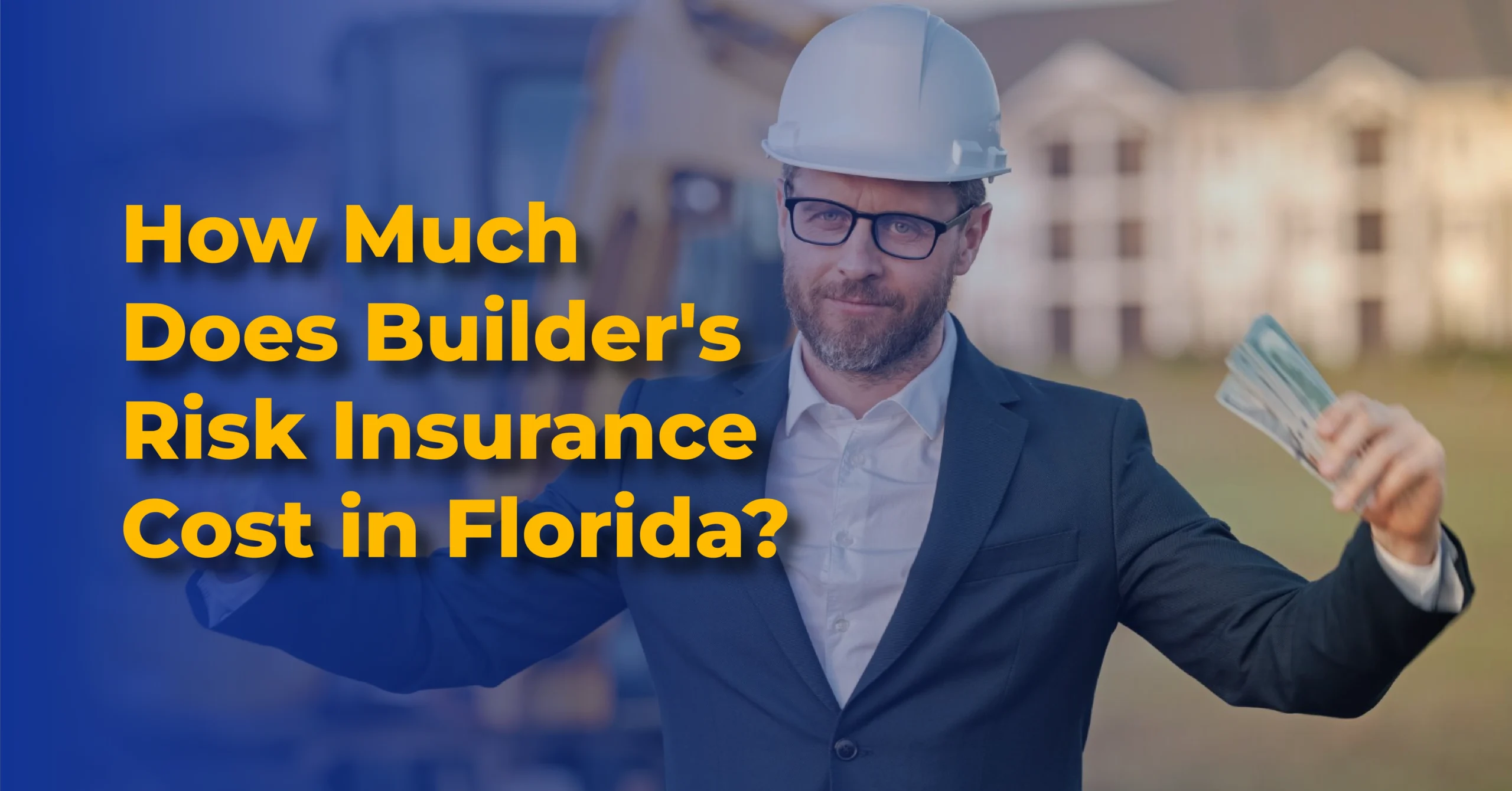When buying builder’s risk insurance, you must ask yourself: How much will builders risk insurance cost and whether you need it for your business? Some clients may not know it, but this policy is more affordable than they think.
Because Florida is a high-risk state for natural disasters, insurance premiums will increase by 30% between 2021 and 2022. Homeowners have to pay some of the most expensive premiums in the country. By 2023, the average annual premium will be approximately $10,996, more than four times the national average of $2,377. Due to severe weather events (especially hurricanes), there’s a disparity compared to the rest of the country, which has led to increased claims and higher costs.
If you have a budget of $100,000 for a renovation, the policy will cover between $1,000 and $5,000. While the cost of builder’s risk insurance varies, most companies pay between 1% and 5% of the total cost of the construction project.
Project Type of Builders Risk Insurance Cost
Typically, construction projects are categorized as: New Construction, Remodeling, and Installation. Each construction project is different, and its cost will be different depending on the type. Remodeling, new construction, and installation all have their type of risk that affects their respective premiums.
Insure installations are usually less costly, this is because they’re shorter and they don’t require a lot of involvement. On the other hand, remodeling projects can come with significant risk, most involve structural changes, so their builder’s risk cost is usually higher.
Building activities are always associated with risks so comprehensive insurance coverage can protect against financial losses and coverage gaps for construction projects.
The materials used in construction also affect insurance premiums. Projects using fire-resistive materials typically cost less to insure compared to wood frame structures due to the lower risk of fire damage. Understanding hard costs, such as materials and labor, is crucial as they directly impact insurance premiums and play a significant role in effective risk management.
Location of Builders Risk Insurance Cost
Your policy can be heavily influenced by location, especially when there’s a construction project in an area like Florida that’s prone to natural disasters. Like commercial property insurance, there can often be significantly higher premiums due to increased risk.
It works just as well in a region where there’s a high crime rate or frequent incidents of vandalism. Understanding how a builder’s risk varies based on location is critical to ensuring adequate coverage and avoiding personal gaps that could leave your project financially vulnerable.
Who needs Builders Risk Insurance Cost Policy?
Organizations and companies that work in renovation and construction need builder’s risk insurance in Florida. This policy provides a safety net against unexpected accidents that might cause financial losses, here are some examples:
1. Property Owners & Homeowners: People who are renovating their homes or businesses that are under construction need to protect themselves from potential damage or theft.
2. General Contractors: Contractors are responsible for managing the project and obtaining insurance coverage, especially if required by the contract. This policy protects labor, materials and potential liabilities.
3. Subcontractors: Subcontractors need to have their own builder’s risk policy, even though general contractors usually provide coverage. They need to protect their specific scope of work, tools, and materials.
4. Developers & Investors: Those financing commercial or residential developments need builder’s risk coverage to protect against losses that could disrupt the project and impact their investment.
5. Lenders & Financial Institutions: Before approving loans, banks and mortgage lenders are required to have builder’s risk insurance to protect their financial interests in case of damage or delays.
6. Architects & Engineers: Design professionals are not typically required to have a policy, but if they’re involved in a project, there needs to be a policy that ensures the parties, especially if their work is integral to the construction.
7. Municipalities & Government Entities: Taxpayer-funded infrastructure projects also require builder’s risk insurance. They need to be protected from unforeseen damage.
8. Business Owners Expanding or Renovating: Potential losses during construction can also happen to companies that are in the process of building new space or even renovating; builder’s risk can cover offices, retail stores, or warehouses.
In short, anyone with a financial stake in a construction project should consider a builder’s risk insurance to protect against unexpected damage, theft, or other risks.
What Does Builders Risk Insurance Cover? (Hards and Soft Costs)
Contractors and property owners engaged in construction or renovation projects are covered under builder’s risk insurance in Florida. This policy acts as a safeguard against unexpected events that could damage structures and some other common risks, including theft, fire, vandalism, vehicle collisions, and some weather-related incidents such as windstorms, hail, and lightning.
In some cases, you can extend your Builder’s Risk Policy to cover debris removal and temporary structures like scaffolding. However, while it’s an essential layer of protection, this policy has limitations. It does not cover damage caused by poor workmanship, defective materials, or negligence. For these risks, additional coverage like Professional Liability or Errors and Omissions insurance may be necessary.
Typical exclusions in Builder’s Risk policies include wear and tear, employee theft, rust, corrosion, and mechanical failure. Standard policies also exclude flood and earthquake damage unless specific endorsements are added. Soft costs, such as legal fees and additional financing expenses, are often omitted and may require special endorsements to be covered.
Understanding when the Project Coverage Begins and Ends
The builder’s risk is only effective during the duration of the project. Contractors must keep in mind that the policy doesn’t cover damages resulting from poor workmanship, defective materials, and negligence by either the contractor or the property owner.
- Beginning of Builder’s Risk Insurance This policy is effective when the project begins. Sometimes builder’s risk insurance is effective when materials are delivered to the job site before physical construction begins. It must be purchased before the commencement of work so that you are protected against unforeseen events such as fire, theft, vandalism, and weather-related damage.
- End of Builder’s Risk Insurance: This insurance provides coverage until the project is completed or reaches a pre-determined percentage of completion. This can be either when the owners accept the work, when the building is occupied, or when a certificate of occupancy is issued. At this point, the builder’s risk becomes a permanent property insurance policy, such as commercial property or homeowners insurance, to continue to protect the structure.
Additional fees and taxes
The type of carrier also affects the cost of a builder’s risk insurance. Nonadmitted carriers often add fees, such as policy fees and surplus line taxes, to the cost of builders’ risk insurance.
For example, if there are any mid-term changes, such as extending or adjusting the coverage period, you may be charged additional endorsement fees.
Conclusion
Builder’s Risk Insurance is essential for contractors, developers, and property owners, protecting construction projects from unexpected risks like theft, fire, vandalism, and weather damage. Without it, costly setbacks could delay progress and increase expenses, putting your investment at risk.
This coverage ensures that materials, equipment, and structures under construction are financially protected, allowing projects to stay on track. In an industry where unpredictability is common, Builder’s Risk Insurance isn’t just a smart choice—it’s necessary for keeping your projects secure and your business financially stable.
Call to Action
If you’re planning a construction project, the first thing you should secure is Builder’s Risk Insurance. Protect your investment before work begins—construction comes with risks. Get a Builder’s Risk Insurance quote today with Litespeed Insurance and safeguard your project from unexpected setbacks!
FAQS – How Much Does Builders Risk Insurance Cost in Florida?
What happens if you don’t have Builder’s Risk?
When you buy builder’s risk, you’re protected against significant financial risks, including financial loss or physical damage. Without it, you’re exposed to theft, project delays, increased costs, liability issues, credit and contract breaches, and no coverage for soft costs.
How is Builder’s Risk Insurance Calculated?
Every project is different, so your insurance will vary depending on the project. Ensuring comprehensive coverage helps protect against damage and costly losses during a construction project. Getting an accurate quote is easier when you work with an insurance provider who can assess your specific needs.
Does the builder’s risk insurance cover bodily injury?
No, personal injury, visitors and third parties are not covered by builder’s risk insurance. The policy is not designed to be effective at the construction site, but is specifically designed to cover property risks (damage to the building under construction), theft, vandalism and some weather-related events. General Liability and Workers’ Compensation would be your best options if you need protection against bodily injury.
Is builder’s risk the same as property insurance?
Builder’s risk insurance is temporary and covers construction-related risks, while property insurance is permanent and protects completed buildings. Both are critical at different stages of a project.
Can both the contractor and the owner buy the builder’s risk insurance?
Yes, both the contractor and the owner can purchase the builder’s risk insurance, but typically only one policy is needed per project. Which party is responsible for securing the policy depends on the contract arrangement and financial interest in the project.
Who pays for builder’s risk insurance?
Once you read the terms and conditions of a contract, you will always know who is responsible for paying the builder’s risk insurance. Usually, the party with the largest financial stake in the project is the one who pays. Ultimately, who pays depends on the contract agreement, but ensuring proper coverage is a top priority.
Let’s Discover more About Litespeed
How Long Can you Operate a Business Without a License?





